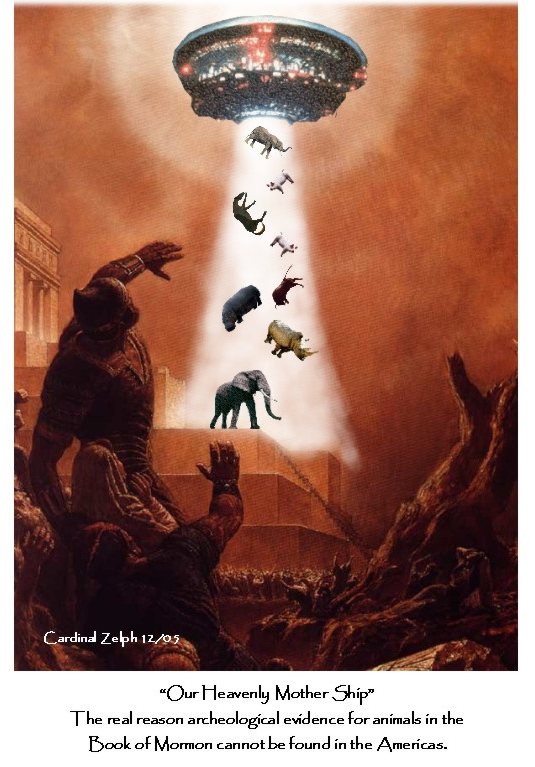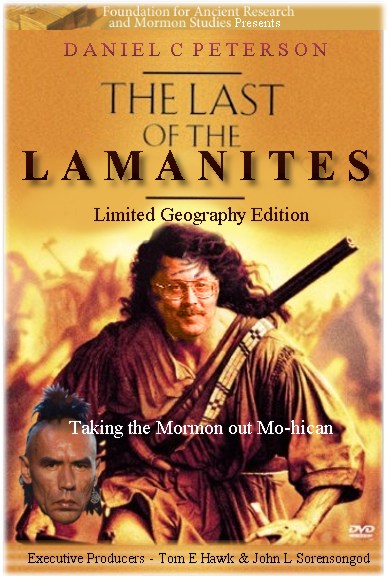A Danish Setting for the Book of Mormon
Posted: Mon Nov 06, 2006 10:15 pm
I posted this on RfM, but I thought I'd post over here because I think the parody points out how strained the "parallels" are between Book of Mormon names and places and Middle Eastern counterparts. What do you think?
In light of recent scientific and linguistic studies, FARMS researchers have further refined the Limited Geography Theory to a definite location: Denmark.
"Think about it," said an obviously excited Daniel Midgley-Welch. "For 176 years we've been focused on the American continent, which has been problematic to say the least. Suddenly, it all makes sense."
BYU linguist Regal Scowser explained that many Book of Mormon names can be traced to Danish origins. Surviving Danish surnames, for example, reflect Book of Mormon names in a striking manner: Hellaman, Ammen, and Lamen, for example, and the name Lehe refers to a county in Denmark, which may shed some light on the birthplace of the Book of Mormon Lehi.
Even some of the more unusual Nephite names turn out to be combinations of Danish words. Take for example, the name Pacumeni. "What sounds like a made-up name is actually a compound Danish word," explained Scowser. "Pak means "riff-raff" or "the masses", and umage means "great effort," thus Pacumeni might be considered as one who had to make great effort as a result of the people, and lo and behold, Pacumeni indeed gave up his desires for the Nephite throne when he found that the people objected. That must have taken a great effort indeed."
Midgley-Welch pointed out a few other word pairs that work out nicely:
Pahoran = Pak (masses) + horen (to hear), meaning a king selected by the voice of the people, just as outlined in the scriptures.
Kishkumen = Kirke (church) + kommen (comings and goings), and we know that Kishkumen was someone who left the church.
Gidgiddoni = Gid (I wish) + jonglere (to juggle), meaning "I wish I could juggle."
Corianton = korenden (currants)
Cumorah = Kummer (grief) + om (about), meaning place of grief, which fits the ultimate scene of Nephite destruction perfectly.
Moriancumr = Morian (dark-skinned) + kummer (grief), meaning a dark skinned person who suffered grief.
Coriantumr = Currants + grief, meaning evil fruits, which would describe this Jaredite king well.
Moroni = Moro (amusement) + ni (nine), meaning that Mormon had nine years of joy from his son
Zarahemla = Zar (ruler) + akeleje (flower), meaning the beautiful place where the ruler dwells.
Gadianton = Gad (preterite of "gide" to choose) + hone (roast chicken) + ton (ton), meaning, "I might choose an enormous roast chicken, which fits in with what we know about the greed of these robbers.
Midgley-Welch went on to explain that a Danish setting resolves many of the alleged anachronisms in the book: "Horses, chariots, steel, swords--they're all there. No more need to talk about tapirs and sledges. And the DNA matches completely! The remnant of the Danish Lamanites are indeed Danes, just as we expect."
In light of recent scientific and linguistic studies, FARMS researchers have further refined the Limited Geography Theory to a definite location: Denmark.
"Think about it," said an obviously excited Daniel Midgley-Welch. "For 176 years we've been focused on the American continent, which has been problematic to say the least. Suddenly, it all makes sense."
BYU linguist Regal Scowser explained that many Book of Mormon names can be traced to Danish origins. Surviving Danish surnames, for example, reflect Book of Mormon names in a striking manner: Hellaman, Ammen, and Lamen, for example, and the name Lehe refers to a county in Denmark, which may shed some light on the birthplace of the Book of Mormon Lehi.
Even some of the more unusual Nephite names turn out to be combinations of Danish words. Take for example, the name Pacumeni. "What sounds like a made-up name is actually a compound Danish word," explained Scowser. "Pak means "riff-raff" or "the masses", and umage means "great effort," thus Pacumeni might be considered as one who had to make great effort as a result of the people, and lo and behold, Pacumeni indeed gave up his desires for the Nephite throne when he found that the people objected. That must have taken a great effort indeed."
Midgley-Welch pointed out a few other word pairs that work out nicely:
Pahoran = Pak (masses) + horen (to hear), meaning a king selected by the voice of the people, just as outlined in the scriptures.
Kishkumen = Kirke (church) + kommen (comings and goings), and we know that Kishkumen was someone who left the church.
Gidgiddoni = Gid (I wish) + jonglere (to juggle), meaning "I wish I could juggle."
Corianton = korenden (currants)
Cumorah = Kummer (grief) + om (about), meaning place of grief, which fits the ultimate scene of Nephite destruction perfectly.
Moriancumr = Morian (dark-skinned) + kummer (grief), meaning a dark skinned person who suffered grief.
Coriantumr = Currants + grief, meaning evil fruits, which would describe this Jaredite king well.
Moroni = Moro (amusement) + ni (nine), meaning that Mormon had nine years of joy from his son
Zarahemla = Zar (ruler) + akeleje (flower), meaning the beautiful place where the ruler dwells.
Gadianton = Gad (preterite of "gide" to choose) + hone (roast chicken) + ton (ton), meaning, "I might choose an enormous roast chicken, which fits in with what we know about the greed of these robbers.
Midgley-Welch went on to explain that a Danish setting resolves many of the alleged anachronisms in the book: "Horses, chariots, steel, swords--they're all there. No more need to talk about tapirs and sledges. And the DNA matches completely! The remnant of the Danish Lamanites are indeed Danes, just as we expect."

